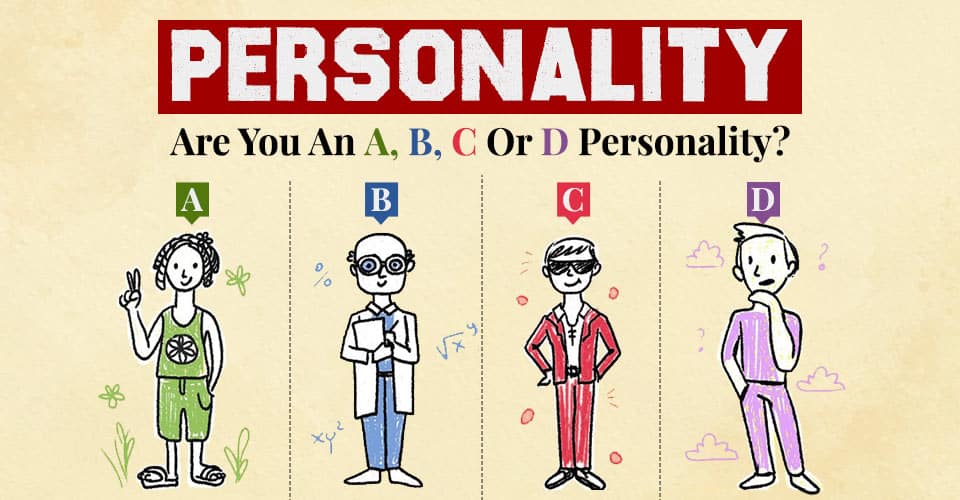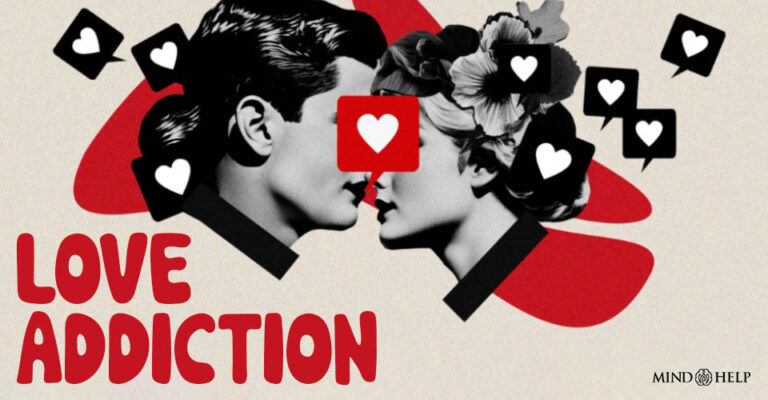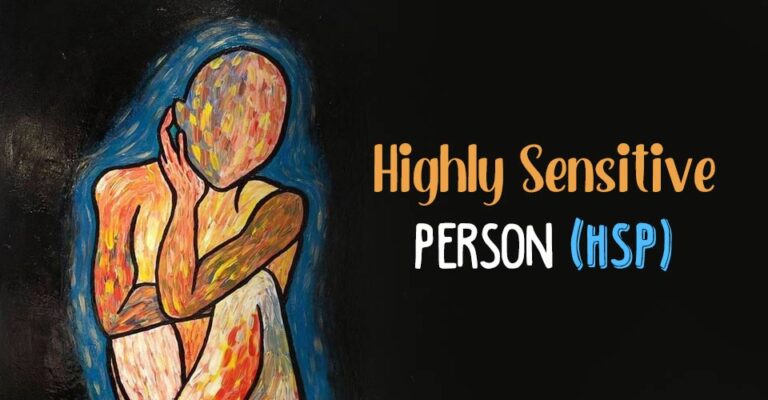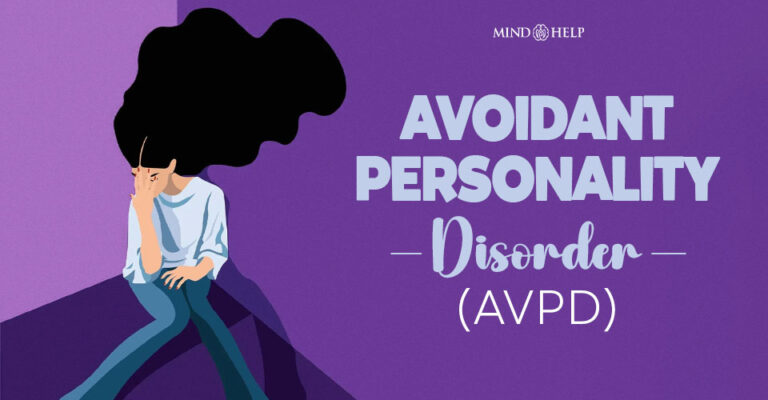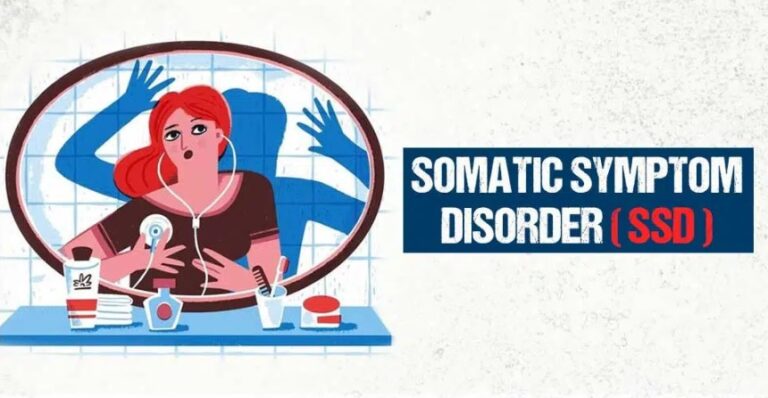Personality refers to a person’s thoughts, emotions, attitude, mood, behavior and opinions that characterize who they are as an individual. It is a crucial aspect of our character and personal identity as self-conscious individuals.
What Is Personality?
It is a collection of our physical, psychological, emotional & social traits which are expressed during our interaction with other individuals, social groups or environment. It is an organized pattern of our behavioral traits, both innate and learned, which make us unique. Usually, one’s personality remains relatively consistent and stable throughout their life. However, it may change over time in certain individuals. Research 1 Roberts, B. W., & Mroczek, D. (2008). Personality Trait Change in Adulthood. Current directions in psychological science, 17(1), 31–35. https://doi.org/10.1111/j.1467-8721.2008.00543.x shows that “personality traits continue to change in adulthood,” due to individual differences, certain life experiences, development and the individual’s stage of life.
Although it is a complex concept to define, it is typically explained as a pattern of cognitions, traits, characteristics and behaviors 2 Nettle, D., & Penke, L. (2010). Personality: bridging the literatures from human psychology and behavioural ecology. Philosophical transactions of the Royal Society of London. Series B, Biological sciences, 365(1560), 4043–4050. https://doi.org/10.1098/rstb.2010.0061 that define who we are. According to a 2019 study 3 Sperandeo, R., Messina, G., Iennaco, D., Sessa, F., Russo, V., Polito, R., Monda, V., Monda, M., Messina, A., Mosca, L. L., Mosca, L., Dell’Orco, S., Moretto, E., Gigante, E., Chiacchio, A., Scognamiglio, C., Carotenuto, M., & Maldonato, N. M. (2020). What Does Personality Mean in the Context of Mental Health? A Topic Modeling Approach Based on Abstracts Published in Pubmed Over the Last 5 Years. Frontiers in psychiatry, 10, 938. https://doi.org/10.3389/fpsyt.2019.00938 , “Interactions between people are governed by patterns of bio-psycho-social processes whose purpose is the adaptation to the environment and which together describe what we define as personality.”
It is often influenced by a number of different factors, such as genetics and environment 4 Hopwood, C. J., Donnellan, M. B., Blonigen, D. M., Krueger, R. F., McGue, M., Iacono, W. G., & Burt, S. A. (2011). Genetic and environmental influences on personality trait stability and growth during the transition to adulthood: a three-wave longitudinal study. Journal of personality and social psychology, 100(3), 545–556. https://doi.org/10.1037/a0022409 which shape us as an individual. All of us tend to be characterized by how we adapt to our environment and relate to or connect with others. This is typically regulated by our personality traits, adds the study.
The term is derived from the ancient Greek and Latin word “persona” which refers to the masks used by actors to play different characters with different identities. Our persona is the hypothetical mask we wear in social situations to portray who we are. However, it is not necessarily a disguise or lie as it indicates partial truth or a specific trait.
History Of Studying Personality
The concept has been studied for over 2,000 years and was originally analyzed by Greek physician Hippocrates. He proposed the “Temperament Theory 5 Goodacre, C. J., & Naylor, W. P. (2020). Evolution of the Temperament Theory and Mental Attitude in Complete Denture Prosthodontics: From Hippocrates 5 Jouanna J. (2010). Hippocrates as Galen’s teacher. Studies in ancient medicine, 35, 1–21. to M.M. House. Journal of prosthodontics : official journal of the American College of Prosthodontists, 29(7), 594–598. https://doi.org/10.1111/jopr.13215 [/mfn] ” which claimed that human behaviors are defined by 4 basic temperaments related with four humors or body fluids, such as –
- Choleric temperament (yellow bile)
- Melancholic temperament (black bile)
- Sanguine temperament (red blood)
- Phlegmatic temperament (white phlegm)
Hippocrates was followed by Greek philosopher and physician Aelius Galenus 6 Viswanathan V. K. (2010). Humor me. Gut microbes, 1(2), 75–76. https://doi.org/10.4161/gmic.1.2.11227 who further developed Hippocrates’ theories. Later, during 1780, German physician Franz Joseph Gall 7 Simpson D. (2005). Phrenology and the neurosciences: contributions of F. J. Gall and J. G. Spurzheim. ANZ journal of surgery, 75(6), 475–482. https://doi.org/10.1111/j.1445-2197.2005.03426.x tried to explain character and personality through the pseudoscience of phrenology 8 Parker Jones, O., Alfaro-Almagro, F., & Jbabdi, S. (2018). An empirical, 21st century evaluation of phrenology. Cortex; a journal devoted to the study of the nervous system and behavior, 106, 26–35. https://doi.org/10.1016/j.cortex.2018.04.011 . Gall believed that personality traits can be evaluated by measuring bumps on the skull.
In the 18th and 19th century, other researchers, such as Immanuel Kant 9 Wiesing U. (2008). Immanuel Kant, his philosophy and medicine. Medicine, health care, and philosophy, 11(2), 221–236. https://doi.org/10.1007/s11019-007-9085-z , further developed the Temperament Theory. However, Austrian neurologist & the founder of psychoanalysis Sigmund Freud’s theory 10 Boag S. (2014). Ego, drives, and the dynamics of internal objects. Frontiers in psychology, 5, 666. https://doi.org/10.3389/fpsyg.2014.00666 of personality is regarded as the first extensive study of the concept. According to a research paper 11 Lantz SE, Ray S. Freud Developmental Theory. [Updated 2021 Feb 7]. In: StatPearls [Internet]. Treasure Island (FL): StatPearls Publishing; 2021 Jan-. Available from: https://www.ncbi.nlm.nih.gov/books/NBK557526/ , Freud’s structural theory of mind “suggests that the psyche (personality) encompasses three psychic structures: the id, ego, and superego.”
1. The Id
It involves inherent, instinctive and primitive behaviors that are completely unconscious 12 Solms, M., & Panksepp, J. (2012). The “id” knows more than the “ego” admits: neuropsychoanalytic and primal consciousness perspectives on the interface between affective and cognitive neuroscience. Brain sciences, 2(2), 147–175. https://doi.org/10.3390/brainsci2020147 & related to psychic energy.
2. The Ego
It originates from the id & helps to express instinctive desires 13 Boag S. (2014). Ego, drives, and the dynamics of internal objects. Frontiers in psychology, 5, 666. https://doi.org/10.3389/fpsyg.2014.00666 in a practical way & helps to cope with reality. It operates in the unconscious, preconscious & conscious mind.
3. The Superego
It regulates 14 Pulcu E. (2014). An evolutionary perspective on gradual formation of superego in the primal horde. Frontiers in psychology, 5, 8. https://doi.org/10.3389/fpsyg.2014.00008 our internal ideals and moral standards learned from caregivers and social interactions. It comprises 2 aspects – The conscience & The ego ideal which help in making decisions & judgments.
Freud proposed that our unconscious mind and psychological conflicts greatly influence our personality and behavior. Freud also believed that our persona and temperament are influenced by various factors, like instinctual drives 15 Compton A. (1983). The current status of the psychoanalytic theory of instinctual drives. I: Drive concept, classification, and development. The Psychoanalytic quarterly, 52(3), 364–401. , aggression, sexual drives 16 Stoléru S. (2014). Reading the Freudian theory of sexual drives from a functional neuroimaging perspective. Frontiers in human neuroscience, 8, 157. https://doi.org/10.3389/fnhum.2014.00157 and childhood sexuality. Freud’s theory was later modified by other researchers and was considered crucial for defining the concept during the 20th century. Later, other important theories were formed involving evolutionary, biological, adaptive, trait, learning, cultural and social aspects.
Read More About Freudian Psychology Here
Understanding Personality
Although the concept can be explained from different perspectives, from a psychological aspect, it primarily involves two definitions. According to the first perspective, every individual possesses unique characteristic traits and there exists steady differences between individuals. Understanding personality enables us to define and categorize these characteristics and differences in people. However, the second psychological explanation focuses on the different traits that makes humans separate from other species as a mental, emotional and intellectual being.
It also highlights how humans are similar to each other and share the same traits. Here, the focus is on the consistent, predictable, regular variables that explains a person’s nature and how they are influenced by other factors. Although this two-way approach helps to gain a better understanding of the concept, it should be noted that no specific definition of the term ‘personality’ is universally accepted.
Fundamentally, it refers to our distinctive behavior patterns which determine how we think, feel, express, act, relate to and interact with others. The study and observation of the phenomenon from a holistic perspective is known as personology 17 Krueger, R. F., Caspi, A., & Moffitt, T. E. (2000). Epidemiological personology: the unifying role of personality in population-based research on problem behaviors. Journal of personality, 68(6), 967–998. https://doi.org/10.1111/1467-6494.00123 . According to American psychologist Henry Alexander Murray 18 Triplet R. G. (1992). Henry A. Murray. The making of a psychologist?. The American psychologist, 47(2), 299–307. https://doi.org/10.1037//0003-066x.47.2.299 ’s theory, our thoughts, emotions, behaviors, reactions, social skills and personal functioning are expressed as a whole individual. Moreover, our personality also acts as an arbitrator between our basic needs and the challenges posed by our external environment. However, it should be noted that the psychological observation of this concept incorporates other fields of study, such as social psychology, philosophy, anthropology and physiology.
Characteristics Of Personality
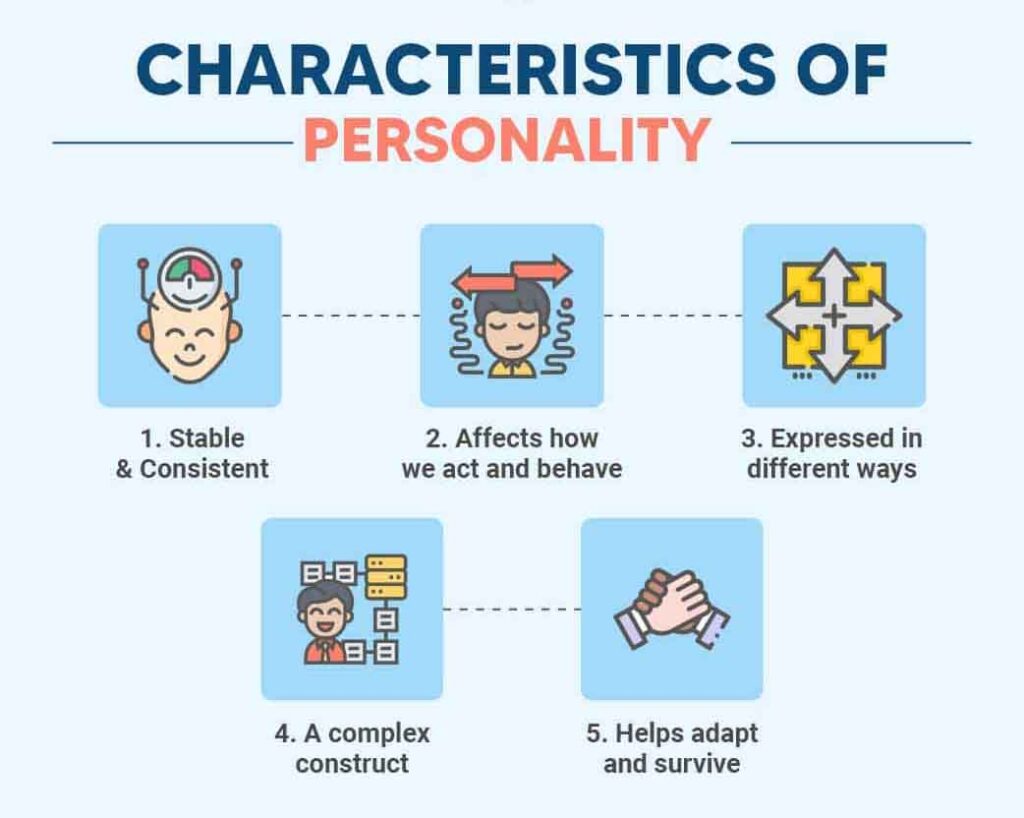
Our personality is believed to be an organized and consistent amalgamation of cognitive, emotional and behavioral mechanisms that affects our interactions with our environment. The following traits, patterns and characteristics are typically observed in a person’s temperament:
1. It is stable & consistent
Our personality is generally structured and doesn’t tend to change randomly 19 Roberts, B. W., & Mroczek, D. (2008). Personality Trait Change in Adulthood. Current directions in psychological science, 17(1), 31–35. https://doi.org/10.1111/j.1467-8721.2008.00543.x in a day. It is based on a pattern of regular thoughts, feelings and behaviors that regulate our daily life. We tend to behave in predictable manners in different circumstances. According to a 2016 study 20 Harris, M. A., Brett, C. E., Johnson, W., & Deary, I. J. (2016). Personality stability from age 14 to age 77 years. Psychology and aging, 31(8), 862–874. https://doi.org/10.1037/pag0000133 , personality tends to remain stable from age 14 to 77 years. “There is evidence for differential stability in personality trait differences, even over decades,” adds the study. Although certain adverse life experiences, like loss, abuse or trauma, can influence our personality, we usually experience minimal and measured changes, if any. But “too much personality change may be bad for one’s health,” found research 21 Human, L. J., Biesanz, J. C., Miller, G. E., Chen, E., Lachman, M. E., & Seeman, T. E. (2013). Is change bad? Personality change is associated with poorer psychological health and greater metabolic syndrome in midlife. Journal of personality, 81(3), 249–260. https://doi.org/10.1111/jopy.12002 .
2. It affects how we act and behave
Our behaviors, actions and reactions are strongly influenced by our temperament and persona. It also affects how we respond to our own needs, emotions, our environment and to others. “Personality features are associated with individual differences in daily emotional life, such as negative and positive affectivity, affect variability and affect reactivity,” adds a 2014 study 22 Komulainen, E., Meskanen, K., Lipsanen, J., Lahti, J. M., Jylhä, P., Melartin, T., Wichers, M., Isometsä, E., & Ekelund, J. (2014). The effect of personality on daily life emotional processes. PloS one, 9(10), e110907. https://doi.org/10.1371/journal.pone.0110907 . Research 23 Hampson S. E. (2008). Mechanisms by Which Childhood Personality Traits Influence Adult Well-being. Current directions in psychological science, 17(4), 264–268. https://doi.org/10.1111/j.1467-8721.2008.00587.x has also shown that it also influences our relationships, expertise, health, wellbeing and addiction.
3. It is expressed in different ways
Personality is not only exhibited through our behaviors and actions, it can also be expressed through our interactions with others in social situations, intimate relationships, level of energy, interests, emotions, thought patterns and attitude. According to a 2017 study 24 Gundogdu, D., Finnerty, A. N., Staiano, J., Teso, S., Passerini, A., Pianesi, F., & Lepri, B. (2017). Investigating the association between social interactions and personality states dynamics. Royal Society open science, 4(9), 170194. https://doi.org/10.1098/rsos.170194 , it influences our behavior and behavioral stability. The study also found that it affects our “belief and attitude.” The study defines it as “a high-level abstraction encompassing traits, which are sets of stable dispositions towards an action, belief and attitude formation.”
4. It is a complex construct
Although we primarily consider the psychological aspect of this concept, our persona and temperament are also strongly influenced by our genetics 25 Krueger, R. F., South, S., Johnson, W., & Iacono, W. (2008). The heritability of personality is not always 50%: gene-environment interactions and correlations between personality and parenting. Journal of personality, 76(6), 1485–1522. https://doi.org/10.1111/j.1467-6494.2008.00529.x and biological needs. A 2018 study 26 Sanchez-Roige, S., Gray, J. C., MacKillop, J., Chen, C. H., & Palmer, A. A. (2018). The genetics of human personality. Genes, brain, and behavior, 17(3), e12439. https://doi.org/10.1111/gbb.12439 revealed that “personality traits are moderately heritable, and can predict various lifetime outcomes, including psychopathology.” However, it may comprise many other characteristics and components, such as environment 27 Briley, D. A., & Tucker-Drob, E. M. (2014). Genetic and environmental continuity in personality development: a meta-analysis. Psychological bulletin, 140(5), 1303–1331. https://doi.org/10.1037/a0037091 and childhood experience 28 Hampson, S. E., Goldberg, L. R., Vogt, T. M., & Dubanoski, J. P. (2007). Mechanisms by which childhood personality traits influence adult health status: educational attainment and healthy behaviors. Health psychology : official journal of the Division of Health Psychology, American Psychological Association, 26(1), 121–125. https://doi.org/10.1037/0278-6133.26.1.121 .
5. It helps us adapt and survive
Our personality empowers us to adapt to any situation and can act as a survival mechanism. Studies 29 Sugiura, M., Nouchi, R., Honda, A., Sato, S., Abe, T., & Imamura, F. (2020). Survival-oriented personality factors are associated with various types of social support in an emergency disaster situation. PloS one, 15(2), e0228875. https://doi.org/10.1371/journal.pone.0228875 have found that personality factors often prove “advantageous for survival.” In fact, research 30 Bijleveld, A. I., Massourakis, G., van der Marel, A., Dekinga, A., Spaans, B., van Gils, J. A., & Piersma, T. (2014). Personality drives physiological adjustments and is not related to survival. Proceedings. Biological sciences, 281(1783), 20133135. https://doi.org/10.1098/rspb.2013.3135 also reveals that it can drive physiological adjustments. It enables us to cope with daily stressors, overcome challenges and enables us to thrive by psychologically and physiologically adapting to our constantly changing environment.
Personality Psychology
It is a vast and prominent field of psychology 31 Larsen, R. J., Buss, D. M., Wismeijer, A., Song, J., & van den Berg, S. M. (2017). Personality psychology: Domains of knowledge about human nature. (2nd ed.) McGraw Hill Education. that studies and analyzes personality and it’s various facets to understand & define why and how we are psychologically similar and different from each other. It also explains why we behave the way we do. This field of study mainly focuses on understanding human nature, individual frame of mind and fundamental psychological processes.
According to a 2011 study 32 Borghans, L., Golsteyn, B. H., Heckman, J., & Humphries, J. E. (2011). Identification Problems in Personality Psychology. Personality and individual differences, 51(3), 315–320. https://doi.org/10.1016/j.paid.2011.03.029 , it is focused on explaining a person as a whole. It assesses the ways everyone is unique by looking at both individual differences and universal traits. “As a sign of its breadth, personality psychology considers both cognitive functioning and personality traits as aspects of personality,” adds the study. It considers personality as a response function which “maps” the traits to manifest our temperament, behavior, emotions and persona.
Experts studying this form of psychology are dedicated to understanding how someone develops their personality and how they are influenced by it throughout their lives. Apart from identifying the similarities and differences in personalities, psychologists also evaluate, diagnose, treat and prevent different types of personality disorders.
Moreover, psychologists also perform various scientific research to understand the personality system and apply the knowledge to the wider field of psychology. One study 33 Funder D. C. (2001). Personality. Annual review of psychology, 52, 197–221. https://doi.org/10.1146/annurev.psych.52.1.197 explains that this field of research is highly important and active today. “The classic psychoanalytic and trait paradigms are active areas of research, the behaviorist paradigm has evolved into a new social-cognitive paradigm, and the humanistic paradigm is a basis of current work on cross-cultural psychology,” adds the study.
Personality Traits
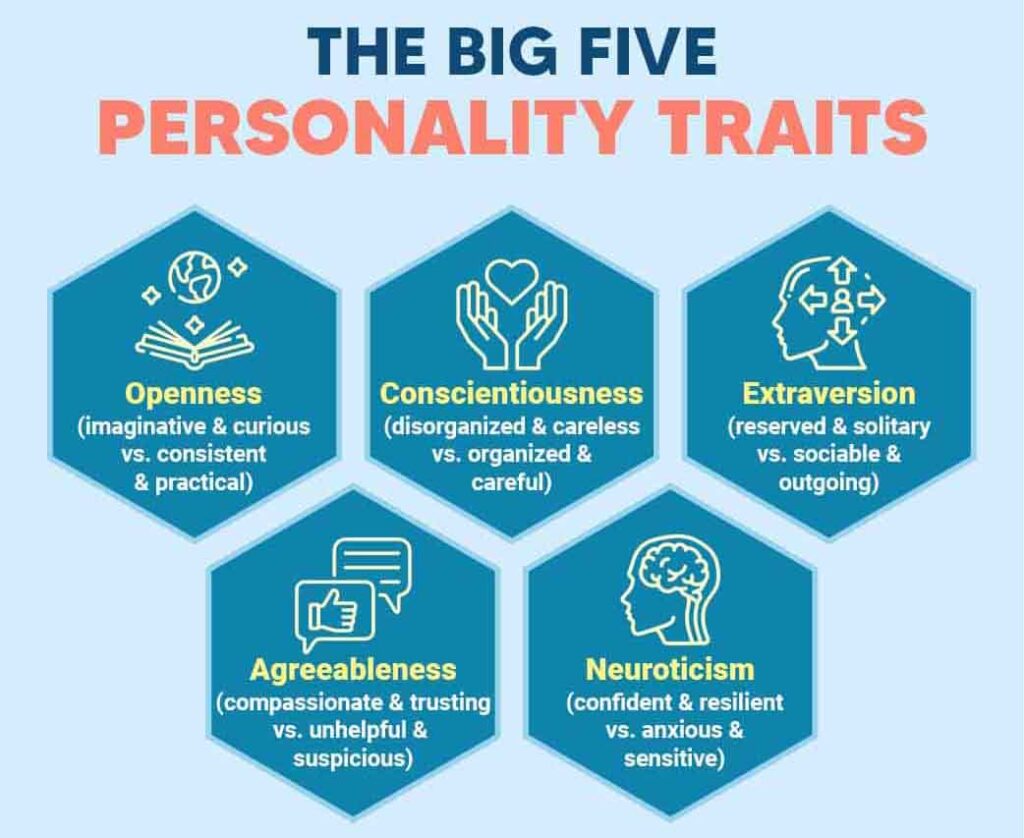
These traits refer to an individual’s stable and consistent thought & behavior patterns. According to a 2015 study 34 McCabe, K. O., & Fleeson, W. (2016). Are traits useful? Explaining trait manifestations as tools in the pursuit of goals. Journal of personality and social psychology, 110(2), 287–301. https://doi.org/10.1037/a0039490 , traits can be defined as “dimensions of individual differences in tendencies to show consistent patterns of thoughts, feelings, and actions.” All of us possess a set of different personality traits in varying degrees that tend to remain stable across circumstances and over time. However, studies 35 Magidson, J. F., Roberts, B. W., Collado-Rodriguez, A., & Lejuez, C. W. (2014). Theory-driven intervention for changing personality: expectancy value theory, behavioral activation, and conscientiousness. Developmental psychology, 50(5), 1442–1450. https://doi.org/10.1037/a0030583 show that such traits are “changeable” and can be modified with intervention.
The Big Five personality traits or the Five-Factor Model (FFM) is the most popular model focused on 5 major traits observed in humans. The Big Five model 36 Roccas, S., Sagiv, L., Schwartz, S. H., & Knafo, A. (2002). The Big Five Personality Factors and Personal Values. Personality and Social Psychology Bulletin, 28(6), 789–801. https://doi.org/10.1177/0146167202289008 was developed during the 1980s to describe certain facets of an individual’s personality, psyche and temperament using certain terms. “The Big Five personality traits model is one of the most established and recognized approaches to describe and measure individual differences in personality,” states a 2015 study 37 Power, R. A., & Pluess, M. (2015). Heritability estimates of the Big Five personality traits based on common genetic variants. Translational psychiatry, 5(7), e604. https://doi.org/10.1038/tp.2015.96 . The five factors identified in the FFM theory include –
1. Openness (imaginative & curious vs. consistent & practical)
Openness to Experience 38 Shi, B., Dai, D. Y., & Lu, Y. (2016). Openness to Experience as a Moderator of the Relationship between Intelligence and Creative Thinking: A Study of Chinese Children in Urban and Rural Areas. Frontiers in psychology, 7, 641. https://doi.org/10.3389/fpsyg.2016.00641 is about a person’s willingness to explore & pursue new opportunities, experiences and interests. Open-minded people are highly insightful and imaginative. It is about a person’s willingness to pursue new experiences and interests.
2. Conscientiousness (disorganized & careless vs. organized & careful)
It refers to an individual’s ability 39 Jackson, J. J., Wood, D., Bogg, T., Walton, K. E., Harms, P. D., & Roberts, B. W. (2010). What do conscientious people do? Development and validation of the Behavioral Indicators of Conscientiousness (BIC). Journal of research in personality, 44(4), 501–511. https://doi.org/10.1016/j.jrp.2010.06.005 for impulse control and thoughtfulness to exhibit goal-oriented behaviors. Someone who is highly conscientious is very organized with consistent behavior.
3. Extraversion (reserved & solitary vs. sociable & outgoing)
Also known as extroversion 40 McCabe, K. O., & Fleeson, W. (2012). What is extraversion for? Integrating trait and motivational perspectives and identifying the purpose of extraversion. Psychological science, 23(12), 1498–1505. https://doi.org/10.1177/0956797612444904 , this trait is marked by expressiveness, assertiveness, sociability and outgoing behavior. Extraverted people gain energy by being social; while people low in this trait, known as introverts, gain energy through solitude and feel drained in social situations.
Read More About Extroversion Here
4. Agreeableness (compassionate & trusting vs. unhelpful & suspicious)
This personality trait is associated with affection, trust, unselfishness & kindness in interpersonal relationships & interactions. Highly agreeable people 41 Ode, S., & Robinson, M. D. (2007). Agreeableness and the Self-Regulation of Negative Affect: Findings Involving the Neuroticism/Somatic Distress Relationship. Personality and individual differences, 43(8), 2137–2148. https://doi.org/10.1016/j.paid.2007.06.035 display prosocial behaviors; while low levels of this trait can make someone exploitative.
Read More About Agreeableness Here
5. Neuroticism (confident & resilient vs. anxious & sensitive)
It refers to one’s emotional stability, distemper and moodiness. Neurotic people 42 Widiger, T. A., & Oltmanns, J. R. (2017). Neuroticism is a fundamental domain of personality with enormous public health implications. World psychiatry : official journal of the World Psychiatric Association (WPA), 16(2), 144–145. https://doi.org/10.1002/wps.20411 suffer from anxiety, sadness and mood swings. People with low neuroticism tend to be emotionally stable and resilient in perceiving their environment.
These traits are typically remembered by using the acronym OCEAN. According to a 2019 study 43 Widiger, T. A., & Crego, C. (2019). The Five Factor Model of personality structure: an update. World psychiatry : official journal of the World Psychiatric Association (WPA), 18(3), 271–272. https://doi.org/10.1002/wps.20658 , the five major traits mentioned in the Big Five model covers the most significant “maladaptive personality trait.” These abnormalities in the traits can help to define different personality disorders mentioned in the Diagnostic and Statistical Manual of Mental Disorders (DSM-5) and the International Classification of Diseases (ICD-10). The study adds “The ICD and DSM personality disorders are readily understood as maladaptive variants of the FFM, but this does not suggest that any measure of the FFM will fully account for every personality disorder.”
Read More About Big 5 Personality Traits Here
Types Of Personality
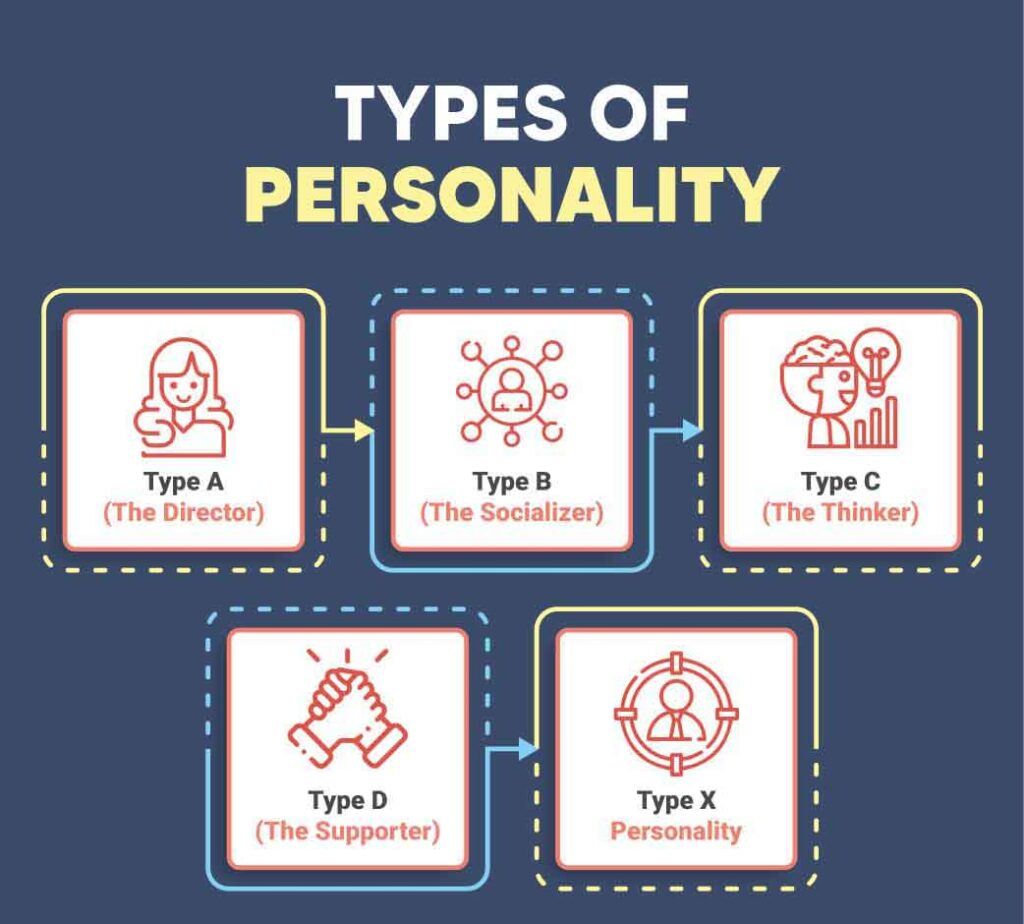
According to psychology, human personality can be divided into different types based on different types of people. However, it should be noted that types are distinct from traits. Types involve qualitative dissimilarities among individuals; while traits refer to patterns of behavioral tendencies and quantitative differences. Personality types are primarily certain categories that classify people according to attitude, mindset, behavior, personality traits and other features.
Although there are different models that explain various types, commonly four primary types of personality are considered by experts, these include –
- Type A: The Director
- Type B: The Socializer
- Type C: The Thinker
- Type D: The Supporter
Understanding how to identify these different types can enable us to better connect with others, work better and build stronger relationships. The four types are briefly discussed below –
1. Type A: The Director
Also known as The Go-Getter or The OverAchiever, people who belong to this category tend to be natural leaders and in charge of their lives. They take control of the situation and are highly practical, no-nonsense and goal-oriented in their approach. They often tend to be obsessed with their work and goals. According to a study 44 Heilbrun, A. B., Jr, & Friedberg, E. B. (1988). Type A personality, self-control, and vulnerability to stress. Journal of personality assessment, 52(3), 420–433. https://doi.org/10.1207/s15327752jpa5203_3 , although Type A behavior is associated with a goal-oriented, driven, hostile-irritable, time-urgent, and competitive mindset, it is also related to high levels of stress and risk of cardiovascular problems, such as coronary heart disease (CHD). “
This pattern of behavior closely resembles the traditional masculine instrumental (goal-oriented) orientation, and, if kept within limits, may be viewed as adaptive in success-oriented, middle-class college students,” adds the study. It is similar to choleric temperament (yellow bile) as proposed by Hippocrates in the Temperament Theory.
Some common traits of Type A may include –
- Dominant
- Passionate
- Ambitious
- Entrepreneurial
- Competitive
- Stubborn
- Motivated
- Born leader
- Goal-oriented
- Risk-taking
- Workaholic
- Impatient
These individuals are driven by success, achievements, money and challenges. However, they tend to get easily stressed and exhausted.
2. Type B: The Socializer
Also called The Peacemaker, people with Type B behavior tend to be highly energetic, outgoing and friendly. Typically an extrovert, they enjoy having a fast-paced life and building meaningful interpersonal relationships. They love being around people, typically have a positive attitude and love to attract attention from others. However, at times people with this personality type can become needy as they have a strong need for external validation and approval. They feel driven by words of admiration, compliments, applause, acknowledgement and public recognition. It has similarities with the sanguine temperament (red blood) mentioned in the Hippocrates model.
Here are some of the most noticeable traits of Type B –
- Social & people-oriented
- Charismatic
- Self-confident
- Enthusiastic
- Easygoing
- Accepting
- Relaxed
- Friendliness
- Impatient
- Self-involved & self-indulgent
- Impulsive & spontaneous
- Trouble being alone
They tend to be highly open and accepting towards change in life. In fact, studies 45 Hisam, A., Rahman, M. U., Mashhadi, S. F., & Raza, G. (2014). Type A and Type B personality among Undergraduate Medical Students: Need for psychosocial rehabilitation. Pakistan journal of medical sciences, 30(6), 1304–1307. https://doi.org/10.12669/pjms.306.5541 have found that Type B individuals experience lower levels of stress and do not feel overwhelmed when goals are not achieved. “They are rarely harried and have low or no desire to obtain a wildly increasing number of things in an ever-decreasing amount of time,” explains a 2004 study 46 Gan, S. H., Ismail, R., Wan Adnan, W. A., Zulmi, W., Kumaraswamy, N., & Larmie, E. T. (2004). Relationship between Type A and B personality and debrisoquine hydroxylation capacity. British journal of clinical pharmacology, 57(6), 785–789. https://doi.org/10.1111/j.1365-2125.2004.02076.x .
3. Type C: The Thinker
This type is often identified as The Scientist or The Analyst as they are detail-oriented people who focus on gaining control and being accurate. Mostly introverted, these individuals rely more on logic and rationality than emotions to understand and perceive their reality and the world around them. They prefer to be invested in activities that are stable and controlled. Hence, they may have difficulties coping with emotional people around them. According to Hippocrates’ model, this type belongs to the Melancholic temperament (black bile) category.
Type C individuals may exhibit the following common traits –
- Accuracy
- Detail-oriented
- Logical
- Focused
- Critical thinker
- Independent
- Dependable
- Creative & imaginative
- Organized
- Analytical, intelligent & thoughtful
- Detached & disengaged behavior
- Skeptical & pessimistic
Research 47 Rymarczyk, K., Turbacz, A., Strus, W., & Cieciuch, J. (2020). Type C Personality: Conceptual Refinement and Preliminary Operationalization. Frontiers in psychology, 11, 552740. https://doi.org/10.3389/fpsyg.2020.552740 shows that Type C is associated with introversion and neuroticism and may be prone to the development of cancer 48 Blatný, M., & Adam, Z. (2008). Osobnost typu C (cancer personality): soucasný stav poznatků a implikace pro dalsí výzkum [Type C personality (cancer personality): current view and implications for future research]. Vnitrni lekarstvi, 54(6), 638–645. . Moreover, they also have a higher risk of experiencing depression 49 Wei, M., Guo, L., Zhu, Y., Guo, Y., Yv, S., Namassevayam, G., Xue, W., Li, J., Li, L., Shen, Z., Yv, J., Zhu, Z., Wang, W., Liu, Y., Zhao, J., & Chen, F. (2019). Type C Personality and Depression Among Newly Diagnosed Breast Cancer Patients: The Mediating Role of Sense of Coherence. Neuropsychiatric disease and treatment, 15, 3519–3529. https://doi.org/10.2147/NDT.S230278 .
4. Type D: The Supporter
Also known as The Philosopher, individuals with Type D behavior are believed to be mysterious, emotional and sensitive. They tend to experience intense feelings of happiness and joyfulness but are prone to succumbing to depression & anxiety 50 Pedersen, S. S., van Domburg, R. T., Theuns, D. A., Jordaens, L., & Erdman, R. A. (2004). Type D personality is associated with increased anxiety and depressive symptoms in patients with an implantable cardioverter defibrillator and their partners. Psychosomatic medicine, 66(5), 714–719. https://doi.org/10.1097/01.psy.0000132874.52202.21 as well. They enjoy living life in an easier and more relaxed pace and seek security in work and relationships. They prefer routines and may dislike frequent changes. Pessimism is an aspect of their personality and they tend to worry about the future. This behavior type is similar to Hippocrates’ Phlegmatic temperament (white phlegm).
Some common traits of Type D typically includes the following –
- Caring & compassionate
- Self-confident
- Reliable & supportive
- Observant & sensitive
- Consistent & stable
- Insightful
- Calm, unimposing & approachable
- Preference for routines & repetitive tasks
- Sincere
- Trusting
- Resistant to change
- Non-assertive & shy
According to a 2005 study 51 Denollet J. (2005). DS14: standard assessment of negative affectivity, social inhibition, and Type D personality. Psychosomatic medicine, 67(1), 89–97. https://doi.org/10.1097/01.psy.0000149256.81953.49 , this behavior type has an inclination to experience negative affectivity & social inhibition. “Type D personality is a vulnerability factor for general psychological distress that affects mental and physical health status and is associated with disease-promoting mechanisms and work-related problems in apparently healthy individuals,” states a 2010 study 52 Mols, F., & Denollet, J. (2010). Type D personality in the general population: a systematic review of health status, mechanisms of disease, and work-related problems. Health and quality of life outcomes, 8, 9. https://doi.org/10.1186/1477-7525-8-9 . Moreover, it is associated with the progression and prognosis of coronary heart disease (CHD 53 Kupper, N., & Denollet, J. (2018). Type D Personality as a Risk Factor in Coronary Heart Disease: a Review of Current Evidence. Current cardiology reports, 20(11), 104. https://doi.org/10.1007/s11886-018-1048-x ).
5. Type X personality
Apart from the main four types mentioned above, a fifth type is also considered to exist by most experts. It is believed when a person possesses more than one personality in equal strength, they are regarded as Type X behavior. The “X” signifies a hybridization or intersection of two or more behavior types. People with Type X tend to behave differently around different people and in different situations.
Myers-Briggs Type Indicator (MBTI)
MBTI is another highly popular model for understanding personality types. “The Myers-Briggs Type Indicator (MBTI) is a psychometric test developed in the 1940s by Isabel Myers and her mother Katherine Briggs,” explains a 2016 study 54 Yang, C., Richard, G., & Durkin, M. (2016). The association between Myers-Briggs Type Indicator and Psychiatry as the specialty choice. International journal of medical education, 7, 48–51. https://doi.org/10.5116/ijme.5698.e2cd . It is a self-report assessment tool for identifying a person’s different psychological perceptions. By using a set of self-aware questions, MBTI helps an individual to recognize their personality type and preferences in the following areas –
- How the receive, direct and utilize their energy
- How they absorb and process information
- How they make decisions & make judgments & conclusions
- How they perceive and approach their reality, environment and external world
According to recent research 55 Woods RA, Hill PB. Myers Brigg. [Updated 2021 Mar 31]. In: StatPearls [Internet]. Treasure Island (FL): StatPearls Publishing; 2021 Jan-. Available from: https://www.ncbi.nlm.nih.gov/books/NBK554596/ , MBTI was developed based on the models & work of Swiss psychiatrist & psychoanalyst Carl Jung 56 Allen J. (1994). Using the Myers Briggs Type Indicator–part of the solution. British journal of nursing (Mark Allen Publishing), 3(9), 473–477. https://doi.org/10.12968/bjon.1994.3.9.473 . This personality inventory was developed during the Second World War by American writer Isabel Briggs Myers and her mother Katharine Cook Briggs to better understand “working relationships between health care professionals, particularly nurses.”
This self-assessment allows individuals to identify their own persona & temperament from 16 different personality types. These personalities are not ranked in any order as not a single type is better or worse than the other. It should be noted that MBTI is meant for identifying a person’s strengths, weaknesses, thought & behavior patterns, preferences and how they relate to others. It is not meant for identifying any disorders or dysfunctions.
The inventory is based on 4 primary scales based on certain traits, such as –
1. Extraversion (E) or Introversion (I)
This scale is focused on directing energy. People with extraversion 57 Fishman, I., Ng, R., & Bellugi, U. (2011). Do extraverts process social stimuli differently from introverts?. Cognitive neuroscience, 2(2), 67–73. https://doi.org/10.1080/17588928.2010.527434 direct their energy towards the outer world and feel energized by being with people and experiencing new things. People with introversion 58 Tuovinen, S., Tang, X., & Salmela-Aro, K. (2020). Introversion and Social Engagement: Scale Validation, Their Interaction, and Positive Association With Self-Esteem. Frontiers in psychology, 11, 590748. https://doi.org/10.3389/fpsyg.2020.590748 focus their energy inwards and are energized by thoughts, reflections and their inner world.
2. Sensing (S) or Intuition (N)
This scale 59 Van Rooij J. J. (1996). The Jungian psychological functions Sensing and Intuition and the preference for art. Psychological reports, 79(3 Pt 2), 1216–1218. https://doi.org/10.2466/pr0.1996.79.3f.1216 analyzes how we perceive information. Sensing refers to processing information obtained from our senses and is concerned with real events. iNtuition is about gaining information from associations and is concerned with possible events that may occur.
3. Thinking (T) or Feeling (F)
These traits focus on making decisions. People with the Thinking trait make decisions based on logic and rationality after analyzing a situation in a dispassionate way. Individuals with the Feeling trait make decisions by relying on values and understand a situation by considering human motives & drives.
4. Judging (J) or Perceiving (P)
This scale is concerned 60 Choong, E. J., & Varathan, K. D. (2021). Predicting judging-perceiving of Myers-Briggs Type Indicator (MBTI) in online social forum. PeerJ, 9, e11382. https://doi.org/10.7717/peerj.11382 with preferring structure. Judging refers to living an organized & planned life with satisfaction from decisions. Perceiving refers to living an adaptable & spontaneous life with open options and possibilities.
With the help of these traits, a person can accurately find out their four-letter personality type after taking the test. The 16 four-letter types listed in the MBTI include the following –
- ISTJ – The Inspector
- ISTP – The Crafter
- ISFJ – The Protector
- ISFP – The Artist
- INFJ – The Advocate
- INFP – The Mediator
- INTJ – The Architect
- INTP – The Thinker
- ESTP – The Persuader
- ESTJ – The Director
- ESFP – The Performer
- ESFJ – The Caregiver
- ENFP – The Champion
- ENFJ – The Giver
- ENTP – The Debater
- ENTJ – The Commander
A 2016 study 61 Myers S. (2016). Myers-Briggs typology and Jungian individuation. The Journal of analytical psychology, 61(3), 289–308. https://doi.org/10.1111/1468-5922.12233 states “Myers-Briggs typology is widely seen as equivalent to and representative of Jungian theory by the users of the Myers-Briggs Type Indicator (MBTI) and similar questionnaires.”
Read More About Myers-Briggs Here
Personality Disorders

Personality disorders refers to a set of mental disorders involving unhealthy, maladaptive and abnormal patterns of cognition, thoughts, mood, functioning, behavior and emotions. Sufferers with these conditions have difficulty understanding and perceiving other people and situations. However, this can adversely affect their education, work, relationships, social interactions and personal life.
According to a research paper 62 Fariba K, Gupta V, Kass E. Personality Disorder. [Updated 2021 Jun 9]. In: StatPearls [Internet]. Treasure Island (FL): StatPearls Publishing; 2021 Jan-. Available from: https://www.ncbi.nlm.nih.gov/books/NBK556058/ , “Persons who have personality disorders experience distorted perceptions of reality and abnormal affective responses, ultimately manifesting in distress across all aspects of the individual’s life.” These conditions are the manifestation 63 Ekselius L. (2018). Personality disorder: a disease in disguise. Upsala journal of medical sciences, 123(4), 194–204. https://doi.org/10.1080/03009734.2018.1526235 of extreme personality traits. These mental disorders tend to develop 64 Guilé, J. M., & Greenfield, B. (2004). Introduction personality disorders in childhood and adolescence. The Canadian child and adolescent psychiatry review = La revue canadienne de psychiatrie de l’enfant et de l’adolescent, 13(3), 51–52. during childhood, adolescence or young adulthood.
There are different types of personality disorders categorized under the following classifications –
1. Cluster A personality disorders
This cluster 65 Esterberg, M. L., Goulding, S. M., & Walker, E. F. (2010). Cluster A Personality Disorders: Schizotypal, Schizoid and Paranoid Personality Disorders in Childhood and Adolescence. Journal of psychopathology and behavioral assessment, 32(4), 515–528. https://doi.org/10.1007/s10862-010-9183-8 includes the following mental illnesses-
- Paranoid personality disorder
- Schizoid personality disorder
- Schizotypal personality disorder
2. Cluster B personality disorders
People with Cluster B disorders 66 Torgersen, S., Myers, J., Reichborn-Kjennerud, T., Røysamb, E., Kubarych, T. S., & Kendler, K. S. (2012). The heritability of Cluster B personality disorders assessed both by personal interview and questionnaire. Journal of personality disorders, 26(6), 848–866. https://doi.org/10.1521/pedi.2012.26.6.848 may suffer from these conditions-
- Antisocial personality disorder
- Borderline personality disorder
- Histrionic personality disorder
- Narcissistic personality disorder
Read More About Cluster B Personality Disorders Here
3. Cluster C personality disorders
The final cluster 67 Hutsebaut, J., Willemsen, E., & Van, H. L. (2018). Tijd voor cluster C-persoonlijkheids-stoornissen: state of the art [Time for cluster C personality disorders: state of the art]. Tijdschrift voor psychiatrie, 60(5), 306–314. includes anxious disorders, like –
- Avoidant personality disorder
- Dependent personality disorder
- Obsessive-compulsive personality disorder
Takeaway
Personality is a vast and complex phenomenon as every individual has a distinct persona with a set of similarities that define consistent thoughts and behaviors. It affects how we connect with ourselves, our loved ones and others. Gaining a better understanding of the concept can enable us to realize our true potential and build a better life for ourselves and others.
Personality At A Glance
- Personality is a collection of our physical, psychological, emotional & social traits. It involves our thoughts, emotions, attitude, mood, behavior and opinions.
- Personality has been studied for over 2,000 years and was originally analyzed by Greek physician Hippocrates.
- Our personality is generally stable and structured. It doesn’t tend to change randomly in a day.
- Personality psychology is a vast and prominent field of psychology that studies and analyzes personality and its various facets.
- The Big Five personality traits or the Five-Factor Model (FFM) is the most popular model focused on 5 major traits observed in humans.
- Commonly four primary types of personality are considered by experts, namely Type A (The Director), Type B (The Socializer), Type C (The Thinker) and Type D (The Supporter).
- MBTI is a highly popular model for understanding personality types.
- Personality disorders refer to a set of mental disorders involving unhealthy, maladaptive and abnormal patterns of cognition, thoughts, mood, functioning, behavior and emotions.
